Though often overshadowed by boots, jackets, and snowboards, snowboard bindings are a crucial piece of your boarding setup. So to help you find the right gear, we've rounded up the best snowboard bindings on the market. But first, let's check out a few things you'll want to know before you shop.
Do snowboard binding straps really matter?
Long story short, yes! Your choice of snowboard bindings can seriously impact your ride. Your binding straps do more than just physically connect you to your board. They determine your field of motion and how responsive your snowboard feels beneath your feet. The right pair of bindings will maximize comfort, board control, and precision during riding.
How to Choose Snowboard Bindings
Changing your bindings can change your ride, for better or worse. It's crucial to find a pair that complements your board, boots, and riding style. Here are a few things to consider to ensure you find the right set:
Snowboard Binding Parts
Before you start shopping, you'll need to have a good understanding of the anatomy of your snowboard bindings. You'll find these parts on every set:
- Baseplates— Sometimes called the chassis, the baseplate connects your foot to the board. They absorb impact and minimize vibration to provide a smooth, comfortable ride with less foot and ankle fatigue.
- Straps— Unless you're using step-ons, your bindings will have two straps: one on the ankle and one on the toe. The best straps come equipped with padding for added comfort.
- Buckles— Most strap-on bindings use a ratchet system for easy entry, exit, and mid-ride adjustments. While cheap buckles are made with plastic, high-quality fasteners are made from lightweight, durable metals like aluminum or magnesium.
- Heel Cup— At the base of your highbacks, you'll find metal or plastic loops called heel cups. Adjust yours for a snug fit that keeps your feet comfortable and securely in place on any terrain.
- Highback— The all-important highback (sometimes called a hi-back) is the vertical plate behind your ankle and lower calf. A tall, stiff highback delivers ample control and the ultimate reactivity, making it an excellent choice for advanced boarders. A shorter, softer highback is ideal for beginners and freestyle riders who want more mobility.
Types of Snowboard Bindings
The type of snowboard bindings you use depends on your personal preference, as each comes with its own advantages, disadvantages, and unique feel. Let's take a look at the three most popular styles on the market today.
- Strap-in bindings— When in doubt, stick to classic strap-in bindings. Most pairs come with two straps across the toe and ankle that can easily be adjusted for a customizable fit. While they're not the fastest, they're the most reliable and versatile. They're an excellent option for beginner boarders.
- Rear-Entry Bindings— If you hate wasting time strapping in, these convenient bindings are for you. As the name suggests, rear-entry bindings have a hinged highback for easy entry. Just slide your foot in, lock the switch, and you're ready to board.
- Step-On Bindings— These innovative bindings offer a hassle-free binding solution that streamlines your setup. Instead of strapping in, your boots connect to the board with a quick click. Though they may take a few trips to the mountain to get used to your new step-on bindings, they'll keep your feet comfortable through every last run. Note, step-on bindings are only compatible with step-on snowboarding boots.
Responsiveness
The shape and flexibility of your bindings determine how responsive they feel. Choosing the right flex is key to a comfortable ride:
- Soft— Lightweight, flexible bindings offer the most mobility, making them a popular choice for freestyle riding. They often feature shorter highbacks that allow riders to lean, bend, and tweak their grabs.
- Medium— For maximum versatility, stick with medium flex snowboard bindings. They offer the right balance of mobility and support to take on any run.
- Stiff— Designed to offer superior precision and control, stiff bindings can be unforgiving. They're often equipped with tall highbacks and carbon materials. Only experienced riders should use freeride bindings.
Price
Remember, your bindings are just as important as your boots and board. Cheap products often fall short on comfort, quality, and safety. It's worth splurging on a high-quality set you'll love for seasons and seasons to come. With that being said, there are still plenty of great options at an affordable price point. If you're shopping on a budget, stick to reputable brands that experienced boarders trust like Union, Burton, and Flow.
Compatibility
Lastly, you'll need to ensure your bindings, board, and boots are all compatible. Your snowboard will be fitted and fine tune with one of the four systems available today:
- 2 x 4
- 4 x 4
- Burton 3D
- The Channel
Durability
Since snowboard bindings are not cheap, you want to purchase one that resist breaking down over repeat impacts so feel free to stomp all the kickers.
8 Best Snowboard Bindings
01
Out of 08
Best Overall

When it comes to snowboard bindings, These Flite Pro Snowboard Bindings are tough to beat. Don't let the affordable price fool you. Thanks to Forma ankle straps, Channel binding systems, and universal disk mounts, they're incredibly versatile, durable, and comfortable. Medium-soft flex and an ultra-light design offer a playful feel that handles any terrain. Plus, Thermoformed EVA bushings absorb shock to help park rats nail every last landing.
Style— Strap-In
Flex— Medium
Price— $
02
Out of 08
Best Rear-Entry Bindings

The Flow Nexus Snowboard Binding can do it all! A Nexus baseplate is rockered for minimal contact with your board. Rounded edges allow your board to flex naturally underfoot, creating a responsive feel for quick, surfy turns. Flow's revolutionary rear-entry binding technology offers a quick, convenient entry. A grippy toe strap and locking ratchet keep you locked in place for total security throughout your ride.
Style— Rear-entry
Flex— Medium
Price— $
03
Out of 08
Best for Aggressive Riders

For hardcore shredding, there are these lightweight, ultra-durable Burton X EST Snowboard Bindings. The innovative bindings blend cutting-edge technology with contemporary aesthetics to please even the most aggressive rider. SpringBED cushioning keeps you close to your board while minimizing impact and reducing fatigue. A Hammockstrap and Capstrap with Double-Take buckles provide quick access and ensure a secure hold. They're an excellent all-mountain option that can handle any powder, park, or icy double black diamond run.
Style— Strap-In
Flex— Medium-Stiff
Price— $$$$
04
Out of 08
Best Step-On Snowboard Binding

Your skier friends won't need to wait on you to strap in anymore, thanks to Burton's Step-On Re:Flex Snowboard Bindings. The innovative boot-to-binding system connects your boots and board without any straps or ratchets. Three connection points, two at the toe and one at the heel, and a quick-release lever on the hi-back provide an easy entrance and exit every time. The vertical highback and micro front lean adjustments maximize performance and control. Burton's Re:Flex Mounting System and Re:Flex FullBED Cushioning System provides plenty of cushions underfoot to minimize fatigue without added weight.
Style— Step-On
Flex— Medium
Price— $$$
05
Out of 08
Best for Freestyle Snowboarding

If you spend most of your day at the park, opt for a pair of bindings with a softer flex. These Sequoia Snowboard Bindings from Arbor offer the flexibility and control you need to play around at the park and tweak grabs. An asymmetrical highback with forward lean adjustment provides all-day comfort. The System-X baseplate responds quickly while minimizing contact between your feet and board for a playful ride. They mount on any 4 x 4 disc.
Style— Strap-In
Flex— Medium
Price— $$
06
Out of 08
Most Responsive

Try these versatile Scribe Re: Flex Snowboard Bindings from Burton for a playful ride on any terrain. The lightweight design features Living Hinge, a single-component baseplate, hi-back dials, and comfort-focused straps with Smooth Glide buckles. Its Re: Flex mounting plate is compatible with all major mounting systems, making it suitable for almost any board. Burton's medium-flex bindings offer intermediate riders the right amount of responsiveness and cushion.
Style— Strap-In
Flex— Medium
Price— $$
07
Out of 08
Best for Backcountry Boarding

Backcountry boarding requires a binding— like the Union Explorer FC Splitboard Binding— that offers superior durability and powerful response. Its lightweight Forged Carbon baseplate and heel cup are tough enough to handle rough backcountry terrain. Magnesium S1 ratchets keep a light feel while keeping you secure through every ride. An updated forward lean adjuster allows riders to decrease the highback angle when you're traveling uphill. Union's unique split interfacing corkscrews to your board for a solid connection that's adjustable with the slip of a pin.
Style— Strap-In
Flex— Rigid
Price— $$$$
08
Out of 08
Best on a Budget

While other affordable snowboard bindings may fall short on quality, these Union Rosa Snowboard Bindings do anything but. Inspired by professional-level designs, they bring just the right balance of comfort, durability, and stiffness for everyday boarding. Lightweight Duraflex materials, a Forma ankle strap, and extruded heel cups hold your feet securely in place for maximum control with minimum drag. The universal disk is compatible with any mount.
Style— Strap-In
Flex— Medium
Price— $

